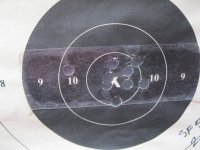I was casually considering a Red Dot sight for my pistol, guess that my wife noticed me viewing the videos and gifted me one for Christmas.
Don't have a clue about the Dot sights. Since my questions are general in nature I thought I'd post in the General Discussion area rather than Pistols or Optics sections.
So some help please...
The general recommendation is to mount the Dot sight as far forward as possible for best field of view. Tried both, don't see much difference. The forward location exaggerates my wobbling, would it be better to mount directly over my hand to minimize the motion?
I notice that changing head or hand position a little bit moves the reticle all over the place but the reticle to barrel relationship appears to remain (relatively) constant. How critical is head/hand position? Would I be better off mounting the Dot sight on a rifle?
Seems that the Dot sights are designed for quick acquisition of man-sized targets, in low light, at very short range... like intruders in the house Are the Dot sights suitable for head-shots on chipmunks at 15 feet or should I stick with iron sights?
Are the Dot sights suitable for head-shots on chipmunks at 15 feet or should I stick with iron sights?
Suggestions/recommendations/comments please!
So, mount far forward or at the back?


Don't have a clue about the Dot sights. Since my questions are general in nature I thought I'd post in the General Discussion area rather than Pistols or Optics sections.
So some help please...
The general recommendation is to mount the Dot sight as far forward as possible for best field of view. Tried both, don't see much difference. The forward location exaggerates my wobbling, would it be better to mount directly over my hand to minimize the motion?
I notice that changing head or hand position a little bit moves the reticle all over the place but the reticle to barrel relationship appears to remain (relatively) constant. How critical is head/hand position? Would I be better off mounting the Dot sight on a rifle?
Seems that the Dot sights are designed for quick acquisition of man-sized targets, in low light, at very short range... like intruders in the house
Suggestions/recommendations/comments please!
So, mount far forward or at the back?

